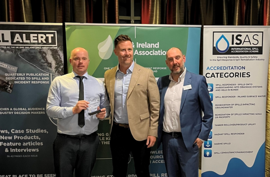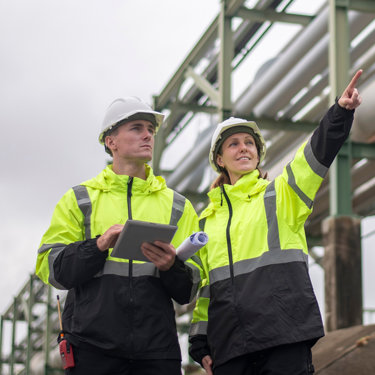Corporate responsibility and sustainability: Addressing PFAS contamination
Published: 22 November 2024
In today’s rapidly evolving business landscape, corporate responsibility and sustainability are no longer optional; they are fundamental for any business to understand and deal with environmental impact and challenges.
A key environmental challenge is that posed by emerging pollutants. One pollutant has seen a significant recent increase in attention from the media, legislators, and the public: per- and polyfluoroalkyl substances, or PFAS as it’s more commonly referred to.

PFAS molecules are sometimes termed ‘forever chemicals’ because they resist being broken down and several of them pose significant risks to human health. PFAS can affect many businesses – even if they don’t directly produce or use it – so it is important to understand how and to quantify those risks. This is the first stage in tackling PFAS and allows businesses to take action to mitigate these risks and operate more sustainably.
Understanding PFAS contamination
Per- and polyfluoroalkyl substances (PFAS) are a group of many thousands of man-made organofluoride compounds consisting of multiple fluorine atoms attached to a carbon chain (which is attracted to oil) and with a 'head' that is attracted to water.
This combination of attraction (and repulsion) to both oil and water, combined with their chemical stability, makes PFAS compounds ideal for many applications, such as non-stick cookware, water-repellent clothing, and firefighting foams.
It is the carbon-fluorine bond in PFAS molecules that makes them notoriously resistant to metabolism and degradation into simpler compounds. Under typical soil conditions, some PFAS can take over 1,000 years to break down, earning them the nickname ‘forever chemicals’.
Because PFAS don’t naturally break down in the environment, they persist to contaminate soils and can also affect drinking water as they migrate. The persistent build-up of PFAS in the environment leads to it entering local wildlife and aquatic life, moving up the food chain through a process called bioaccumulation. Humans can then be exposed to PFAS by consuming contaminated food.
The role of corporate responsibility
Proactive risk management
Corporate responsibility begins with taking a proactive approach to establishing if PFAS contamination is present within your operations and supply chains. The first step is conducting a thorough assessment of PFAS. If, for example, you find evidence of PFAS contamination of your site, then you can affect measures to prevent its migration and further contamination. If it is present in your supply chain, can it be substituted for an easily available alternative?
As the understanding of emerging pollutants continues to evolve, further restrictions and the use of legislation will likely follow. You can get ahead of the curve by anticipating and planning to mitigate future risks.
By pinpointing where PFAS-related risks could exist and quantifying those risks – including how, when, where, and to what extent PFAS may have entered an operation and its subsequent fate – companies can take informed actions to manage and mitigate these risks effectively. Those informed actions can also remove the risk from a company’s balance sheet, and any impact on the company’s value.
As an example, PFAS may have been added – intentionally or unintentionally – to products placed into a supply chain and ultimately onto the market. This could constitute a regulatory risk with the associated reputational risks, loss of business, disposal costs, and other liabilities. If PFAS has passed through an operation, it could manifest itself in both on-site and off-site environmental liabilities that are difficult to quantify and deal with.
On sites where firefighting foam operations have taken place, PFAS is likely to have been released in the past and limiting the spread of contaminated firewater run-off can be challenging. PFAS contamination can spread widely, and rainfall can exacerbate the problem, creating larger volumes of contaminated waters with lower concentrations of PFAS. These contaminated waters cannot be discharged untreated to surface water or even foul water sewers (sewage treatment does not usually remove PFAS). This can create an expensive and difficult problem to solve. Firefighting equipment such as tanks and foam applicators may also need to be decontaminated and tested, or even replaced, before newer fluorine-free foams are used.

Insurance companies are also becoming increasingly concerned about PFAS. This is because PFAS is so long-lasting, the regulatory regime is changing so quickly, and there have been several high-profile and expensive legal cases settled regarding PFAS. It could potentially add up to a significant and long-term risk that cannot easily be quantified. As a result, many insurers are beginning to ask for more information from their insured – or even refusing cover. The advice from the insurance industry is to assess if and how you are affected and, if you do have PFAS exposure in your supply chain or manufacturing process, have a strong plan to transition away from it.
Transparency and accountability
Transparency is a cornerstone of corporate responsibility and fundamental in building and maintaining trust with customers, employees, investors, and the community. The issue of emerging pollutants like PFAS is not one that can or should be ignored. Instead, clearly and consistently communicate with your stakeholders to address any issues around PFAS. This could include detailing the steps being taken to remove it, the progress of these efforts, and the strategies in place to reduce future risks.
- Public reporting that regularly outlines your PFAS management activities and objectives, including data on PFAS levels, the effectiveness of substitution or remediation efforts, and any contamination incidents. It’s also worth noting that public reporting fulfils two important functions: it keeps your stakeholders informed and it holds the company accountable for its environmental impact.
- Stakeholder engagement via forums, meetings, and consultations can help to facilitate two-way communication on PFAS-related issues and allow stakeholders to voice their concerns, providing valuable feedback that can be used to improve current practices.
- Independent third-party audits can verify the accuracy of company reports and the effectiveness of PFAS management strategies, providing an unbiased assessment that can enhance the credibility of the company’s efforts.
- Internal controls can be implemented to robustly monitor and manage PFAS contamination. Examples of internal controls include setting clear policies and procedures, training employees on PFAS management, and establishing a system for tracking and reporting PFAS-related data.
- Performance metrics related to PFAS management can be developed and tracked, measuring the reduction in PFAS levels, the number of remediation projects completed, and the success rate of preventive measures. Measuring performance can help identify areas for improvement and demonstrate progress over time.
- Regulatory compliance with all relevant regulations and standards and staying ahead of statutory requirements not only helps avoid legal penalties but also shows a proactive approach to environmental stewardship.
By being open about your actions, you can build trust with your stakeholders, demonstrate your commitment to corporate responsibility, and ensure that efforts are effective and credible.
Innovation and alternatives
Investing in research and development to find safer alternatives to PFAS isn’t only beneficial for the planet and human health. Where there are risks and challenges, there are also opportunities for innovation, product differentiation, or securing a preferential supply chain position. These opportunities can also open new markets, particularly where stringent environmental regulations exist and a company can already offer products that meet or exceed these standards.
Leading the way by investing in R&D and adopting innovative materials and processes that don’t cause pollution can position your business as a leader in sustainable practices, placing you in a better position to maximise the value of the opportunities while more effectively mitigating material business risks.
Although initial R&D can be costly or time-consuming, finding safer alternatives can lead to future cost savings or prevent business interruptions. Aside from the potential costs of regulatory action, other costs such as waste management and liabilities from PFAS-related health issues can be avoided.
Consumers and businesses alike increasingly value sustainability and ethical practices when making purchasing decisions. Innovation can reduce environmental impact and enhance a company’s brand reputation, increasing customer loyalty and trust. Employees are also more likely to work for (or stay with) a company that aligns with their values and demonstrates a commitment to positive environmental impact. This can make it easier to boost employee morale and attract top talent.
Finally, investors are increasingly considering environmental, social, and governance (ESG) factors in their decisions. Demonstrating leadership in sustainability and innovation can attract more investment and improve overall financial performance.
Collaboration and advocacy
Addressing PFAS as an issue requires a collaborative effort, whether this is in eliminating it from your supply chain or as a pollutant on your site. Businesses need to work with government agencies and regulators and other stakeholders to implement initiatives aimed at reducing PFAS pollution. Investment in R&D can provide opportunities to collaborate with academic institutions, government agencies, and other companies to accelerate innovation and provide access to additional resources and expertise.
It goes without saying that any suppliers should adhere strictly to environmental standards, but it is also important to implement sustainable practices, such as reducing the use of hazardous chemicals and improving waste management. Factoring in longevity, reusability, and recyclability in your product design can also help to reduce waste and the consumption of resources, reducing the need for harmful pollutants like PFAS.
Engaging employees in sustainability initiatives can drive meaningful change from within your business. By empowering your workforce through training and the provision of resources, you can encourage the adoption of sustainable practices which ultimately contribute to the company’s environmental goals.
Consumer education around the problems presented by pollutants like PFAS and the importance of sustainable choices can also play an important role in driving demand for safer products. Leveraging marketing and communication channels to raise awareness can be an effective way of encouraging responsible consumption.
Getting ahead of the problem
The potential for widespread PFAS contamination represents a significant challenge, but it also offers an opportunity to demonstrate leadership in corporate responsibility and sustainability which, in turn, can make your business more attractive to potential investors.
Managing PFAS contamination, removing it from your supply chain if possible, and promoting sustainable practices are critical components of corporate responsibility. Embracing these challenges head-on can not only safeguard your company’s reputation but also pave the way for a healthier planet and a more resilient economy. The time to act is now, and the path forward is clear: proactive management, transparency, innovation, collaboration, and a steadfast commitment to sustainability.
We are at the forefront of tackling emerging pollutants, working with our clients to implement solutions for their removal. Technologies such as granular activated carbon (GAC), reverse osmosis, and ionic exchange can be applied to remove PFAS and other compounds. We are also investigating newer and more innovative processes for the removal and destruction of PFAS. Our commitment extends to research and innovation activities focused on analytical methods, alternative substances and technologies, and remediation of contaminated soil and water.
You might also be interested in...
 Webinar
WebinarFrom PFAS to Lithium Batteries: Understanding Emerging Pollutants’ Business Impacts
 White paper
White paperA Comprehensive Exploration of Business-Relevant Pollutants
 Insights
InsightsAddressing the growing threat of PFAS in the UK
 Insights
InsightsRevolutionising management of forever chemicals: our award-winning PFAS solution
Environmental compliance today, creating a sustainable tomorrow
Helping you reduce risk to the environment and your operation by managing assets compliantly while achieving commercial, ESG, and net-zero goals.
Contact our experts
